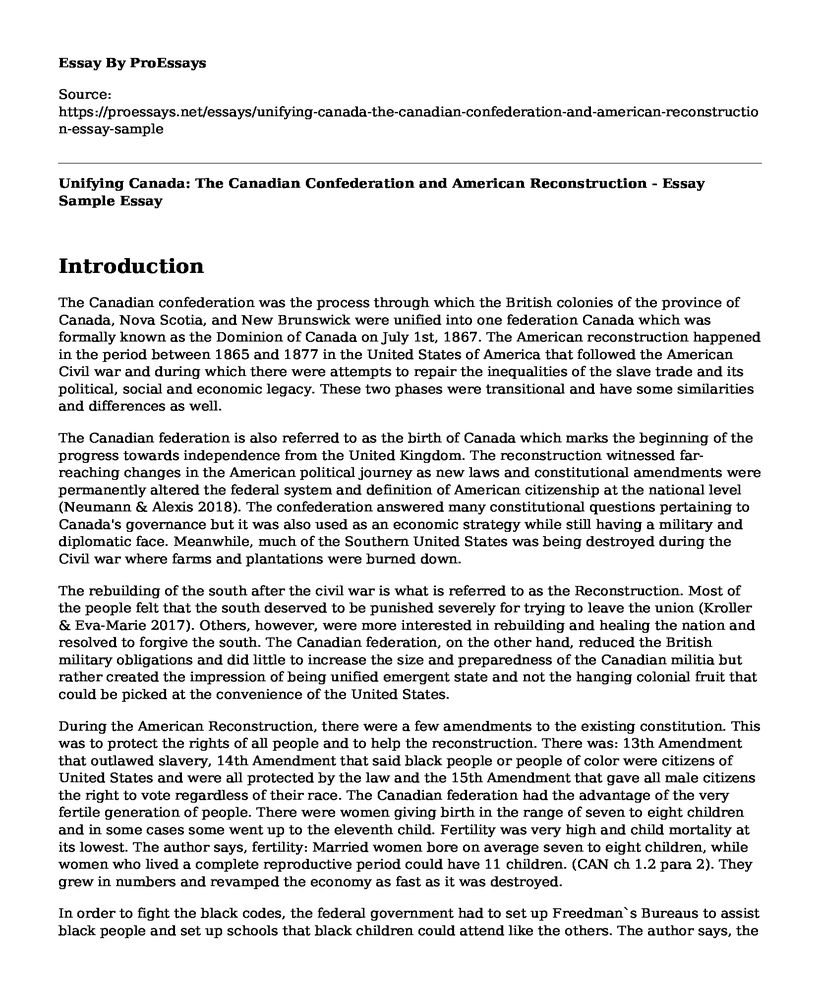Introduction
The Canadian confederation was the process through which the British colonies of the province of Canada, Nova Scotia, and New Brunswick were unified into one federation Canada which was formally known as the Dominion of Canada on July 1st, 1867. The American reconstruction happened in the period between 1865 and 1877 in the United States of America that followed the American Civil war and during which there were attempts to repair the inequalities of the slave trade and its political, social and economic legacy. These two phases were transitional and have some similarities and differences as well.
The Canadian federation is also referred to as the birth of Canada which marks the beginning of the progress towards independence from the United Kingdom. The reconstruction witnessed far-reaching changes in the American political journey as new laws and constitutional amendments were permanently altered the federal system and definition of American citizenship at the national level (Neumann & Alexis 2018). The confederation answered many constitutional questions pertaining to Canada's governance but it was also used as an economic strategy while still having a military and diplomatic face. Meanwhile, much of the Southern United States was being destroyed during the Civil war where farms and plantations were burned down.
The rebuilding of the south after the civil war is what is referred to as the Reconstruction. Most of the people felt that the south deserved to be punished severely for trying to leave the union (Kroller & Eva-Marie 2017). Others, however, were more interested in rebuilding and healing the nation and resolved to forgive the south. The Canadian federation, on the other hand, reduced the British military obligations and did little to increase the size and preparedness of the Canadian militia but rather created the impression of being unified emergent state and not the hanging colonial fruit that could be picked at the convenience of the United States.
During the American Reconstruction, there were a few amendments to the existing constitution. This was to protect the rights of all people and to help the reconstruction. There was: 13th Amendment that outlawed slavery, 14th Amendment that said black people or people of color were citizens of United States and were all protected by the law and the 15th Amendment that gave all male citizens the right to vote regardless of their race. The Canadian federation had the advantage of the very fertile generation of people. There were women giving birth in the range of seven to eight children and in some cases some went up to the eleventh child. Fertility was very high and child mortality at its lowest. The author says, fertility: Married women bore on average seven to eight children, while women who lived a complete reproductive period could have 11 children. (CAN ch 1.2 para 2). They grew in numbers and revamped the economy as fast as it was destroyed.
In order to fight the black codes, the federal government had to set up Freedman`s Bureaus to assist black people and set up schools that black children could attend like the others. The author says, the Freedman`s bureaus engaged in many initiatives to assist the transition from slavery into freedom. (US ch 16.2 para 4). In conclusion, the two phases ended in almost similar ways whereby we see the black people being set free and slavery is abolished. Better human rights were implemented for everyone and living standards greatly improved. We see the two phases end regimes that otherwise were a burden to them and by standing and refusing to be oppressed they made it. It took time but it happened eventually.
Works Cited
Kroller, Eva-Marie, Ed. The Cambridge Companion to Canadian literature. Cambridge University Press, 2017. https://books.google.com/books?hl=en&lr=&id=ok3ODgAAQBAJ&oi=fnd&pg=PR10&dq=canadian+confederation&ots=AywFiDm9WR&sig=kvq3tyfNrVB_QPM-HxbtSUWYH8A
Neumann, Alexis Broderick. "American Incest: Kinship, Sex, and Commerce in Slavery and Reconstruction." (2018). https://repository.upenn.edu/dissertations/AAI13419228/
Cite this page
Unifying Canada: The Canadian Confederation and American Reconstruction - Essay Sample. (2023, Feb 24). Retrieved from https://proessays.net/essays/unifying-canada-the-canadian-confederation-and-american-reconstruction-essay-sample
If you are the original author of this essay and no longer wish to have it published on the ProEssays website, please click below to request its removal:
- Response to Maus' Interpretation of Shakespearean Comedy Essay
- Literary Analysis Essay on Brave New World by Aldous Huxley
- Critical Essay Sample on Role of Women in a Brave New World
- The Themes of Fate and Free Will in Oedipus the King - Critical Essay
- Essay Example on American Business Culture: An Inclusive Land of Opportunity
- Essay on Early Prenatal Care Access for Mexican-American Women: Challenges & Solutions
- 90% of Global Consumers Outside US: Benefits of Business Internationalization - Free Paper







